What is HR service delivery?
HR service delivery is a term used to explain how an organization's human resources (HR) department offers services to and interacts with employees.
Traditionally, HR service delivery was as simple as an open-door policy where employees could stop into an HR office, ask questions, provide information and pick up needed paperwork. However, the modern HR service delivery model is quite different. It involves fewer face-to-face, human-to-human interactions and is driven more by using technology to access and deliver various HR services.
Fueled by technological innovations, such as mobile applications, cloud computing, self-service portals and AI, HR service delivery is evolving rapidly. These technological changes in the business landscape, coupled with many demographic changes in the workforce, are driving the need for fast, timely and focused HR service delivery that enhances employees' workplace experiences.
Importance of HR service delivery
An organization's HR department provides many services to the workforce, including onboarding new employees, offboarding departing employees, payroll processing, employee benefits administration and management, employee experience management and so on.
HR service delivery is the systematic practice of providing these services in a way that enhances employee experience and boosts employees' workplace -- and HR -- satisfaction. The practice is important because HR itself is a core function for organizations. Delivering it as a service helps HR interact with employees better and meet their needs faster and more efficiently.
A systematic, well-planned HR service delivery function enables organizations to improve HR performance and productivity, meet employee expectations and improve the efficiency of monitoring and compliance processes. It also helps align HR with business goals and objectives, thus increasing the value of the HR department to the organization.
Furthermore, it supports HR teams, company leadership and decision-makers by providing the following:
- Actionable, real-time insights into employee needs and satisfaction levels with HR services.
- Information or data to guide the design and delivery of enhanced employee experience.
- Self-service tools that enable more flexibility for employees to do their work with minimal stress, such as those that facilitate telecommuting.
- Automated chatbots and a comprehensive knowledge base to answer employees' frequently asked questions, which helps free HR staff to focus on other strategic tasks.
- Support for developing a successful remote work or hybrid work strategy.
- Streamlined onboarding and offboarding to save time, minimize security risks and ensure compliance with legal regulations and internal company policies.
HR service delivery includes the people, technology and processes that help improve HR services and how they are delivered to the company's employees. It encompasses the entire employee lifecycle, from hiring to exit.
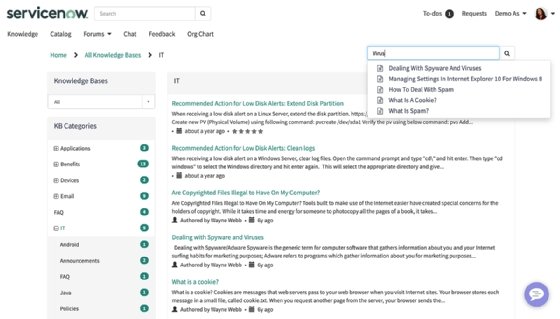
HR service delivery models
Employers can use a variety of methods to deliver HR services to employees. These are known as delivery models, and they are explored below.
Traditional service model
In this model, the HR department consists of HR generalists who perform multiple tasks to manage the organization's HR needs, ranging from hiring and recruiting to benefits management, payroll, and training and development. HR staff usually work locally to support a local employee population and are managed from a central location or department. Localization enables them to work closely with employees to provide hands-on HR services and support.
As remote and hybrid work has become the norm for many organizations, the traditional centralized model has become less feasible and less effective. The model can overwhelm HR teams if they are required to handle a broad range of tasks for a geographically dispersed employee population. Also, the model offers limited scalability for larger employee populations, often resulting in service delivery bottlenecks and poor employee experiences.
Another problem with the traditional model is that HR generalists might not have the in-depth skills or expertise needed to help employees with complex or specialized HR issues. This can also create bottlenecks that slow down service delivery and delay the resolution of employee issues.
Finally, many HR functions in the centralized model often rely on manual processes and paper forms, while using management systems that are frequently disconnected from each other. These challenges create HR inefficiencies, hinder HR team productivity, increase operational costs and negatively affect employee satisfaction and perception of the HR department.
Employee self-service model
The employee self-service (ESS) delivery model gives employees the flexibility and freedom to access the information they need through a knowledge base or chatbots, which are usually available through the company intranet. Today, access to these self-service assets is often provided through information-rich, interactive, social media-like platforms.
Employees log into an ESS platform using a web browser or smartphone application. After logging in, they can access numerous self-service features. For example, they can access and update their information (contact details, social security number, etc.), download pay stubs, put in time-off requests, and so on. Employees can easily access information and various HR services without waiting for a response from HR personnel. This speeds up HR service delivery and reduces its cost. It also reduces the administrative burden on HR staff and helps free up time.
If needed, users can access additional human support for more complex requests. ESS portals improve communication between employees and HR staff by facilitating more focused and personalized interactions between employees and HR staff, accelerating issue resolution and enhancing employee satisfaction with HR services.
The self-service model offers employees more autonomy and control over some HR functions and tasks. This helps foster a culture of responsibility and ownership that enhances workplace engagement, motivation and employee experience.
Most portals include robust security features to protect employee data and aid the organization in maintaining compliance with security and privacy laws. Such features include encryption, multifactor authentication, access controls and data backups.
Shared services model
A shared services model includes HR generalists and specialists who divide the HR workload and responsibilities but work as a single HR unit supporting the entire organization. The model identifies multiple HR roles, such as HR business partners, and employees can access these services using multiple channels, including phone and online.
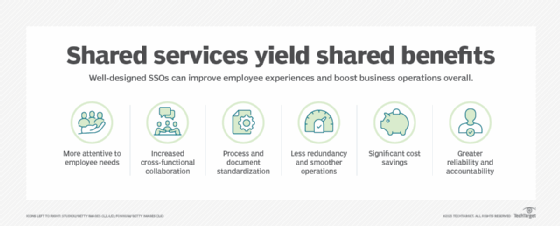
The model is particularly effective for hybrid and remote workforces, since it helps to streamline many HR processes, enhance communication and collaboration and generate cost savings. It can also improve employee productivity, engagement and satisfaction. Employee self-service is usually not part of the shared model.
One potential problem with the shared HR services model is that it can result in HR inefficiencies. The model works by consolidating multiple support functions into one group. If the members of these functions don't collaborate as a team, it could create redundancies and inefficiencies that negatively affect the speed and cost of HR service delivery.
Tiered HR service delivery model
Many modern HR service delivery models follow a tiered architecture, which gives employees access to varying levels of HR expertise and lets organizations allocate and prioritize HR resources effectively.
The tiered HR service delivery model is based on the three-legged model for organizing HR, a concept devised by American academic David Ulrich and presented in his 1997 book, Human Resource Champions.
It combines the advantages of the traditional, self-service and shared service models. Like the shared services model, the tiered model designates multiple roles in the HR department. It also adds self-service to the shared model, enabling employees to find information and solve problems independently while having the option to access additional human-delivered support for more complex issues.
The original model consists of four components and corresponding HR employee roles:
- Shared service activities supported by a call center and corporate intranet.
- Specialists who serve as repositories of key technical knowledge.
- Business partners that work closely with managers on key initiatives and change management.
- A small team of corporate HR personnel that works with business leaders to provide strategic direction to the program.
Today, a tiered model identifies multiple service levels, categorized by the support required from HR. If a request requires more personalized support, not unlike customer personalization, it should be escalated through the tiers. As the tiers progress, the potential for HR automation reduces and the need for human intervention increases.
The tiers are as follows:
- Tier 0. This tier involves self-service using the ESS module of the organization's HR platform. Employees typically use the self-service portal for simple tasks that don't require intervention by the HR team, such as searching for paid-time-off availability, reviewing employee benefits, downloading salary slips, etc.
- Tier 1. In this tier, help requests from employees require general assistance from HR shared services because the problem cannot be solved with self-service. An example might be asking a fundamental question about benefits that is not available in the ESS portal's knowledge base but could be answered with a standardized HR response.
- Tier 2. If a generalist cannot address the problem or request, it is escalated to a specialized HR representative or member of the human resources management team. An example might be a complex question about compensation that requires the input of a subject matter specialist. These specialists might belong to HR centers of excellence consisting of skilled workers with deep expertise in specific areas of HR.
- Tier 3. This tier involves face-to-face interactions between employees, HR representatives and business partners. Requests are escalated to this level only if the tier 1 generalists and tier 2 specialists cannot help with resolution. This tier is often reserved for managing employee relations, succession planning and recruitment, as well as for handling sensitive or high-impact matters, such as legal disputes.
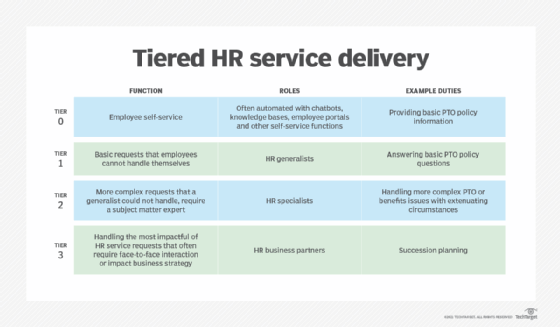
Benefits of HR service delivery
A well-thought-out and planned HR service delivery model can offer multiple benefits to organizations:
- Distributed workload. Successful service delivery, for example, through a modern, tiered model can lessen the workload for HR staff, leaving them time and energy for other critical tasks.
- Improved employee experience. Tiered HR service delivery platforms that offer self-service and access to personalized support improve employee experience, which can help increase employee retention and reduce employee turnover.
- Employee insights. Online HR and employee engagement platforms enable companies to monitor employee interactions and behaviors and derive analytics that capture employee satisfaction and productivity. For example, platforms with AI capabilities can detect employee burnout, while skills management tools help HR understand, manage and improve employees' skills.
- Effective employee sentiment monitoring through KPIs. Rethinking HR service delivery includes thinking about its effectiveness on employee sentiment and motivation. This requires tracking specific key performance indicators (KPI) and metrics. The right KPIs help HR departments measure how successfully they meet their goals in providing services to employees. Examples of KPIs include case volumes, average HR response or resolution time, HR cost per employee, adherence to service-level agreements and most-viewed knowledgebase articles. HR staff can also quantify and track other KPIs to measure service delivery effectiveness, such as employee satisfaction with HR services, turnover rate, time to onboard and time to full employee productivity.
- Opportunities for HR improvement. Modern HR platforms provide actionable data, insights and reports that enable HR teams and company leaders to identify areas of improvement. They can use the insights to identify bottlenecks and implement appropriate steps to improve the timeliness and effectiveness of HR service delivery.
- Cost-effectiveness. The combination of monitoring, employee insights delivered by an HR platform, efficiently distributed HR resources and improved employee satisfaction reduces service delivery costs and improves HR efficiency.
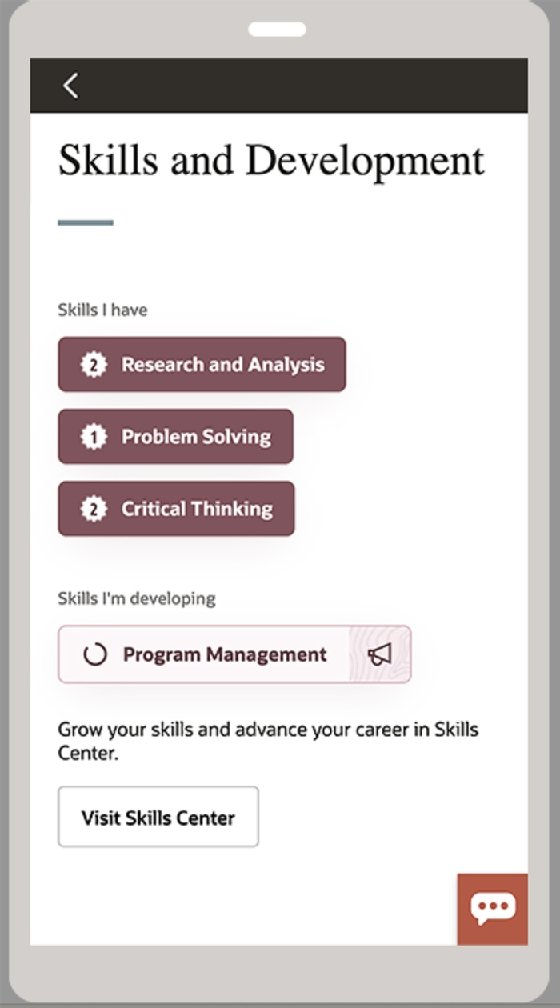
Best practices for HR service delivery
A well-constructed, effective HR service delivery model can deliver the above benefits if the organization adopts the following best practices.
Offer always-available, on-demand self-service. For maximum effectiveness, employees should be able to access important information at all times. Implementing a self-service portal can help with this objective. Self-service capabilities in an HR platform ensure that information and support are available quickly and at the employee's convenience, even when they are away from the workplace or after traditional office hours.
Always be transparent. If employees can't solve their problems through self-service or automated features, they should know the appropriate representative to contact. They should also be able to ask for and learn the status and progress of their requests. Here's where a streamlined ticketing workflow and case escalation mechanism can be helpful.
Stay fast and efficient. HR can speed up request response times by implementing process automation, analytics and reporting, employee case management and employee document management.
Be scalable. The HR service delivery model must remain reliable and consistent as the business changes or grows. This requires using a scalable platform and implementing a tiered architecture to organize workflows and efficiently add or use resources as needed.
Be user-friendly. The HR service delivery platform should offer personalized user experiences. It should be easy for both HR personnel and other employees to use. Further, it should let employees solicit the help of a real person when necessary and access information that is relevant to them. A cloud-based platform usually streamlines these activities. It eases access to HR services, as it can be accessed from any location and any device. Also, since it is delivered as a SaaS product, it requires no additional infrastructure, hardware or software investments, helping to reduce the cost of HR service delivery.
Use appropriate technology. To achieve all these objectives and offer flexible HR service delivery that fosters employee engagement, the model must be strengthened with the right technologies, such as social media platforms, case management tools and AI-enabled insights.
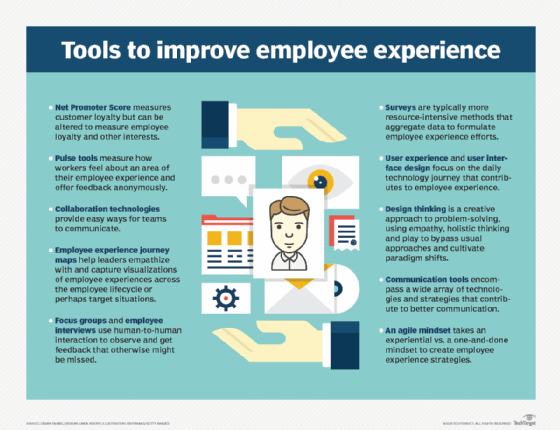
They sound alike, but employee experience and employee engagement aren't interchangeable. HR leaders need to understand both. Learn about the differences between employee experience and employee engagement.







